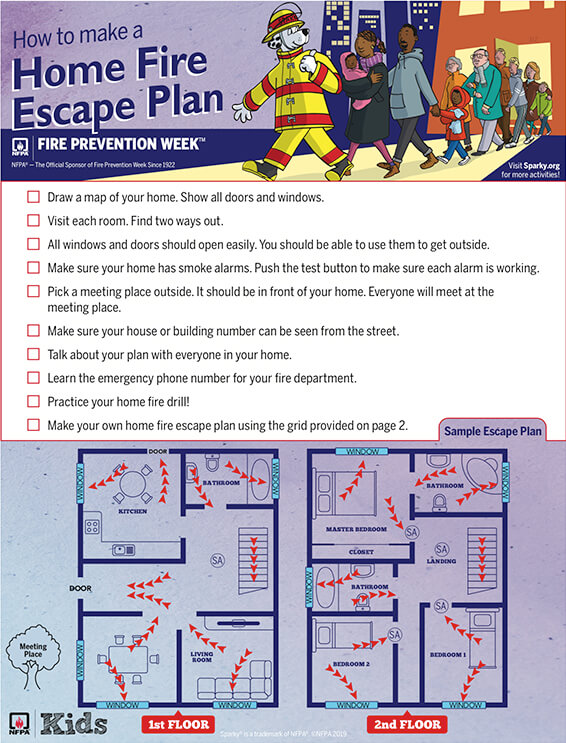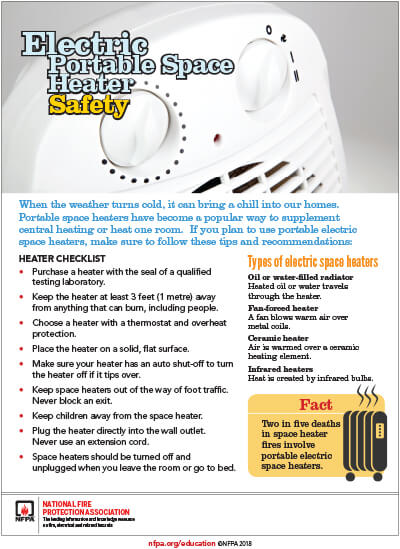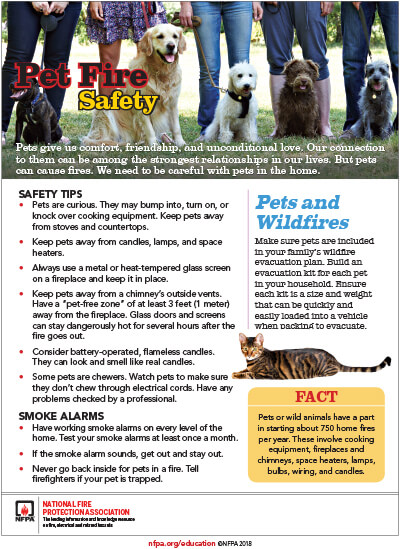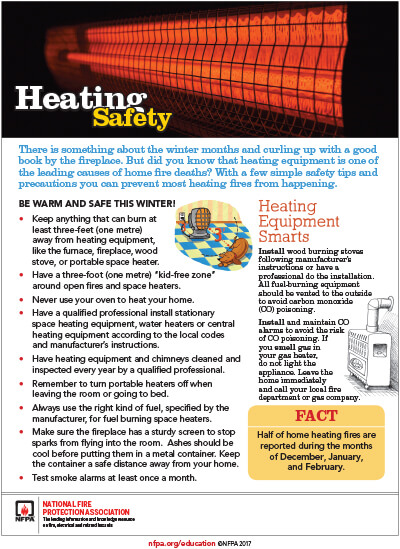Household Safety
The majority of fire deaths in North America happen at home. House fires today burn faster than ever; occupants may have as little as 2–3 minutes to escape safely from the time the smoke alarm sounds.
By using working smoke alarms, Carbon Monoxide alarms and having a home escape plan, you can prevent fires and keep your family and home safe. Here are some more tips you can use to keep your household safe.
Safety Tips
Kitchen Safety
More fires begin in the kitchen than any other room in the home. In fact, residential cooking is one of the leading causes of fire-related deaths. The leading cause of kitchen fires is unattended cooking.
- Stay in the kitchen when you are frying, boiling, grilling or broiling. Keep an eye on what you fry. Turn off the burner if you have to leave for any reason.
- If you are simmering, baking or, roasting food; check it regularly and stay in the home.
- Keep flammable items away from your stove top. Do you have a burned cutting board or wooden spoon in your house? That is evidence of a close call!
- Don’t get distracted! Unattended cooking is the #1 cause of kitchen fires.
- Use oven mitts. Burning your hands on a hot pan can cause you to drop it increasing the likelihood and severity of burns.
- Keep a tight fitting lid close by. If you have a small grease/oil fire on the stove: carefully place a lid or baking sheet over the pot to smother the flames, turn off the heat and wait for the pot to cool. If you have a fire in your oven: keep the door closed and turn off the heat. Wait for the oven to cool before opening it. NEVER use water or portable extinguisher to extinguish a grease/oil fire; this will spread the fire!
- Always check electrical appliances before use to be sure they are in good repair and are in a place where they cannot be knocked over or bumped.
- Keep loose fitting clothing away from the cooking surface.
- Gas, charcoal and wood barbecue grills must only be used outdoors: indoor use can kill occupants by causing a fire or Carbon Monoxide poisoning.
- Keep children and pets 1m (3’) away from the grill or oven.
Smoke Alarms
Smoke alarms double your chance of survival in a house fire. They detect the fire in the early stage of growth and can be the difference between life or death. Learn more
- Install smoke alarms outside each sleeping area and on every level.
- Test smoke alarms once a month.
- Make sure everyone knows what to do when the alarm sounds.
- Clean your smoke alarms every 6 months with a vacuum and soft bristled brush.
- Replace the batteries every year.
- Replace smoke alarms every 10 years.
Carbon Monoxide Alarms
Any household that has fuel burning appliances has the potential to produce Carbon Monoxide emissions. If your smoke alarm does not also do CO detection you can install a stand-alone CO alarm. Learn more
- Install carbon monoxide alarms outside of sleeping areas so you can hear it if you are sleeping.
- Carbon monoxide alarms lose sensitivity over time so replace every 5 years (or sooner in the manufacturer recommends).
- Carbon monoxide poisoning can result from cars left running in garages or from malfunctioning or improperly vented portable generators, water heaters, clothes dryers, furnaces or other heating appliances.
- Headache, nausea and drowsiness are symptoms of carbon monoxide poisoning.
Heating Safety
In the cooler months portable heaters and chimney fires are a significant part of our response demographic. Following these tips will help keep you household safe and warm!
Wood-Burning and Pellet Heaters
- Have a qualified professional install stoves, chimney connectors, and chimneys according to manufacturer’s instructions.
- Only burn dry, seasoned wood (or pellets). Not only is it cleaner for the environment, it also creates less buildup in the chimney.
- Start the fire with newspaper, kindling, or fire starters. Never use flammable liquids such as lighter fluid, kerosene, or gasoline to start a fire. They produce flammable vapours that can easily catch fire.
- Allow ashes to cool before disposing of them. Place ashes in a tightly covered metal container and keep the ash container at least 3 metres (10 feet) away from the home and other nearby buildings. Never empty the ashes directly into a trash can.
- Chimneys and vents need to be cleaned and inspected by a qualified professional at least once a year.
- Keep children and pets away from hot surfaces. Have a “Kid-Free Zone” of at least 1 metre (3 feet) from the surfaces and venting. Glass doors and screens can remain dangerously hot for several hours after the flames go out.
- Closely supervise young children around fireplaces and stoves, use safety gates.
Portable Electric Heaters
- Turn heaters off when you leave the room or go to bed.
- Purchase and use that have an automatic shut-off; if they tip over, they shut off.
- Place space heaters on a solid flat surface and keep them and their cords away from things that can burn, high traffic areas, and doorways.
- Plug space heater directly into a wall outlet. NEVER use an extension cord or power strip!
- Keep all combustibles one meter (3 feet) clear on all sides. Never cover or place anything on the heater to warm or dry.
- Do not plug anything else into the same circuit as the one you are using for the space heater. Doing so could result in overheating.
Electrical Safety
Electricity is very useful and used in many ways around your home from lighting to charging your favourite device. Electricity is also very capable of starting fires if not used correctly. Follow these tips to keep your home safe.
- Electrical work should only be done by a qualified electrician. Ask about the requirement for permits and inspections by Electrical Inspectors for your particular job.
- Keep lamps, light fixtures, and light bulbs away from anything that can burn including: furniture, bedding, curtains, clothing, and flammable or combustible gases and liquids.
- Major appliances (refrigerators, stoves, washers, dryers, microwave ovens, etc.) should be plugged directly into a wall outlet. Never use an extension cord for a major appliance – it can easily overheat and start a fire.
- Check electrical cords often. Replace cracked, damaged and loose electrical or extension cords. Do not try to repair them.
- Avoid putting cords under rugs and carpets, across doorways, or where they can be damaged or pinched by furniture.
- Extension cords are for temporary use only. Have a qualified electrician determine if additional circuits or wall outlets are needed.
- Only use surge protectors or power strips that have internal overload protection. Use surge protectors or power strips that are listed by a qualified testing laboratory (UL, ULC, CSA etc.).
- Only use approved and listed charging blocks and cords for devices. Only use charging cords and blocks that are listed by an approved testing agency (UL, ULC, CSA etc.).
- All switches and wall outlets should be covered with wall plates to prevent shocks.
- Keep ladders at least 3 metres (10 feet) away from overhead power lines. Use fibreglass or wooden ladders outdoors.
- Never touch a downed power or communication line. You could be injured or electrocuted. Assume that all lines are live and stay 10 metres (30 feet) away. Report downed lines to the authorities right away.
- Always “Call Before You Dig” to have underground lines marked. Some power lines are underground.
Smoking
Despite a steady decline in the popularity of cigarette smoking, multiple fires are started every year in our district due to smokers’ materials and related items such as lighters and matches. These tips will help minimize the possibility of fire starts from smoking materials.
- If you smoke, smoke outside.
- Never smoke in bed.
- Wherever you smoke use deep. Sturdy ashtrays. If ashtrays are not available use a metal can or pail. Never empty smoking material directly into a trash can. Place the ashtrays or metal cans away from anything that burns.
- Before you throw out butts and ashes, make sure they are out. Put them out in water or sand.
- Do not throw out cigarettes into vegetation, potted plants, landscaping, peat moss, dried grasses, mulch, leaves or other items — they can easily catch fire.
- Keep cigarettes, lighters, matches and other smoking materials up high and out of reach of children in a locked cabinet.
- Fires have occurred with vaping products, including electronic cigarettes were being used, the battery was being charged, or the device was being transported. Never leave charging E-cigarettes charging unattended. E-cigarettes should be used with caution.
Campfires
Except when prohibited by a Provincial Burn Ban, campfires are permitted in the Sechelt Fire Protection District. (Take a look at the official regulations.) Campfires can be enjoyable when used responsibly. Here are some tips to be sure your fire is safe for you and the environment.
- Closely supervise all outdoor fires. Make sure the fire is out before leaving.
- Supervise children around any fire outdoors including campfires, fire pits, chimineas, and outdoor fireplaces.
- Only burn clean dry wood. Never burn plastics, construction debris, garbage, plastics, treated lumber, tires, pesticide, paint or aerosol containers. These items contain toxins that can be harmful to people and animals when burned.
- Avoid burning on windy, dry days. Embers from open burning can ignite nearby structures or cause a wildfire.
- Never use flammable or combustible fuels to light your fire, the vapours can ignite.
- Prevent wildfire ignitions by being careful with all outdoor burning, avoiding burning on high fire conditions and ALWAYS comply with official burn bans.
Portable Fire Extinguishers
As a general rule, firefighting should be left to professional firefighters. Fire extinguishers are meant for putting out small fires or used to help escape from the area, not firefighting large out-of-control fires. If you do need to use a portable fire extinguisher, keep these tips in mind.
- Before trying to put out or contain a fire, be sure that:
- You know how to use the fire extinguisher and it’s the correct type.
- Everyone else is leaving the home and someone is calling the fire department.
- The fire is small, confined, and not spreading.
- You have a clear escape route and will not be overcome by smoke or toxic fumes.
- Never turn your back to the fire.
- If you don’t feel safe and/or the conditions become unsafe, back out of the room safely and close the door if you can. Then get safely outside and call 9-1-1.
- Where portable fire extinguishers are installed in the home, follow the manufacturer’s instructions for placement and mounting height.
- Locate extinguishers in your home near exits so you have the option of getting safely outside.
- We suggest the average home has an extinguisher with a rating of at least 2-A:10B (5lb ABC type).
- If your group or company would benefit from extinguisher training provided by the Sechelt Fire Department please complete our Extinguisher Training Request Form.
Flammable / Combustible Liquids
Flammable and combustible liquids, which include gasoline, kerosene, lacquers, paint thinner, some cleaning fluids, hair spray, and paint solvents can be fire hazards because their vapours ignite easily. Even nail polish and nail polish remover are flammable and should not be used near an open flame. Here are some more tips to keep your household safe around flammable and combustible liquids.
- Store gasoline in a tightly capped container that is specially sold for that purpose. Store the container outside the home in your garage or garden shed, never in your basement.
- Do not store hazardous liquids near any source of heat, sparks, or flame. That includes electric motors which can spark when they switch on or off.
- Never bring gasoline indoors, even in small quantity.
- Never smoke when you work with flammable or combustible liquids.
- If you spill a flammable liquid on your clothing, place the clothing outside to dry before laundering.
- Keep oil based paints and flammable and combustible solvents in their original containers and tightly capped — never store them in breakable glass containers.
- When re-fueling any small mower such as a lawnmower, snow blower, or string trimmer, make sure the motor has cooled prior to adding fuel. Spilled fuel can easily ignite and cause serious burns.
Home Escape Plans
Home Fire Safety Checklist
Get together with your family and make sure your home is fire safe!
- Is there a working smoke alarm on every level of your home, and outside each sleeping area?
- Have your smoke alarms been tested with the last month to make sure they are working?
- Have the batteries in your smoke alarms been changed in the last year?
- Does your family have a home escape plan?
- Have you practised your home escape plan in the last 6 months?
- Do you have plans to replace any smoke alarm that is older than 10 years?
- Does everyone in your family know what to do when the smoke alarm sounds?
- Does your family have a safe meeting place?













